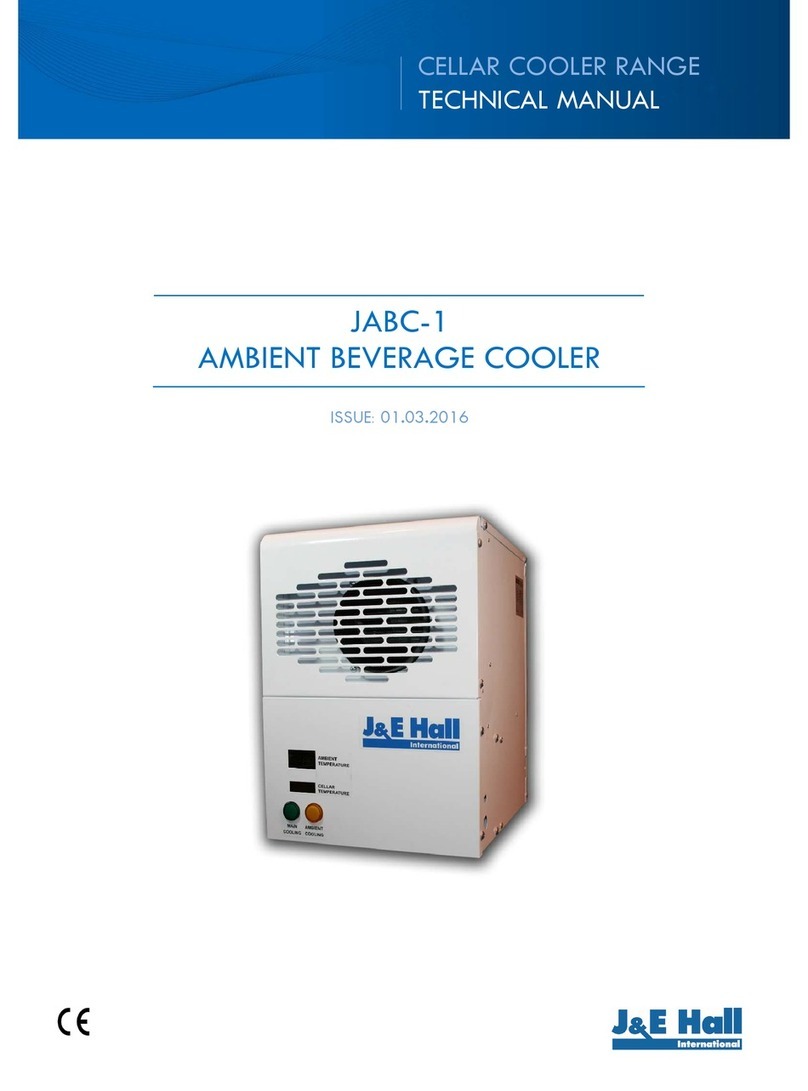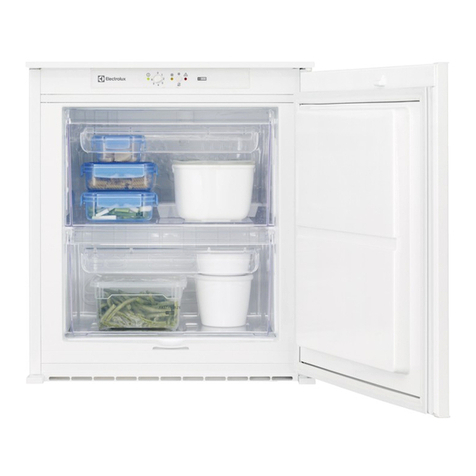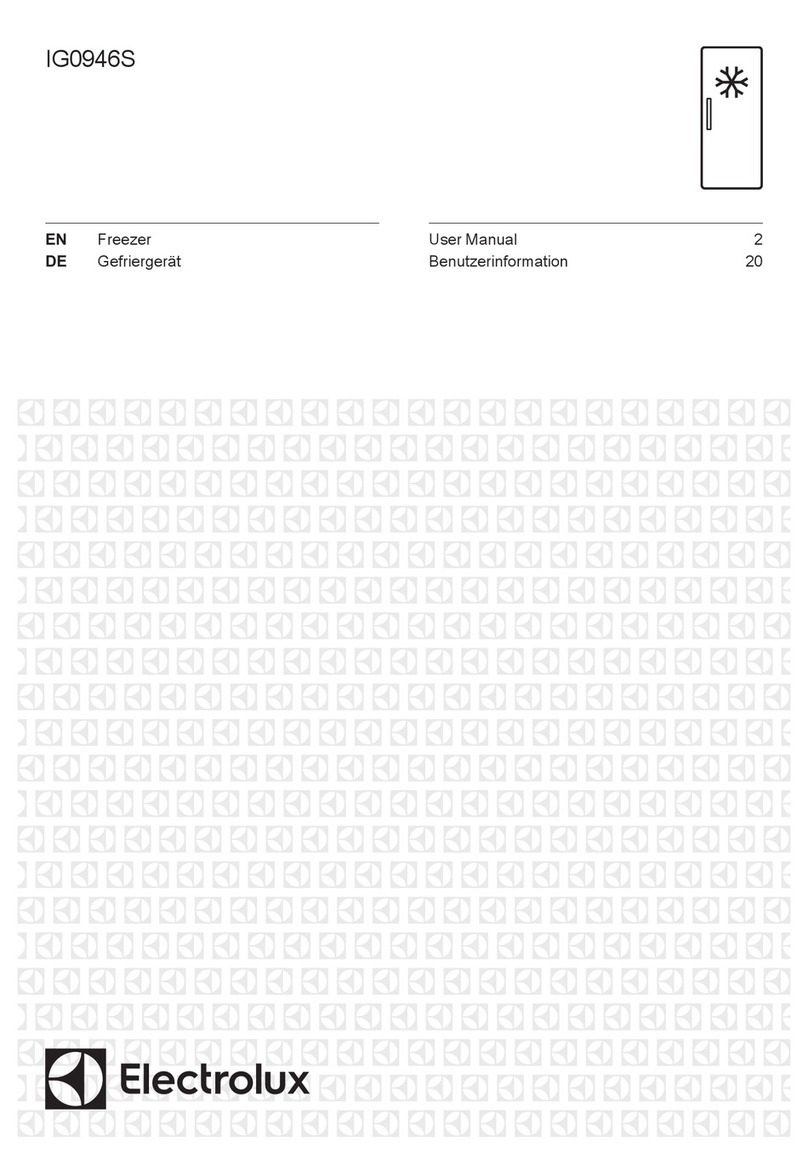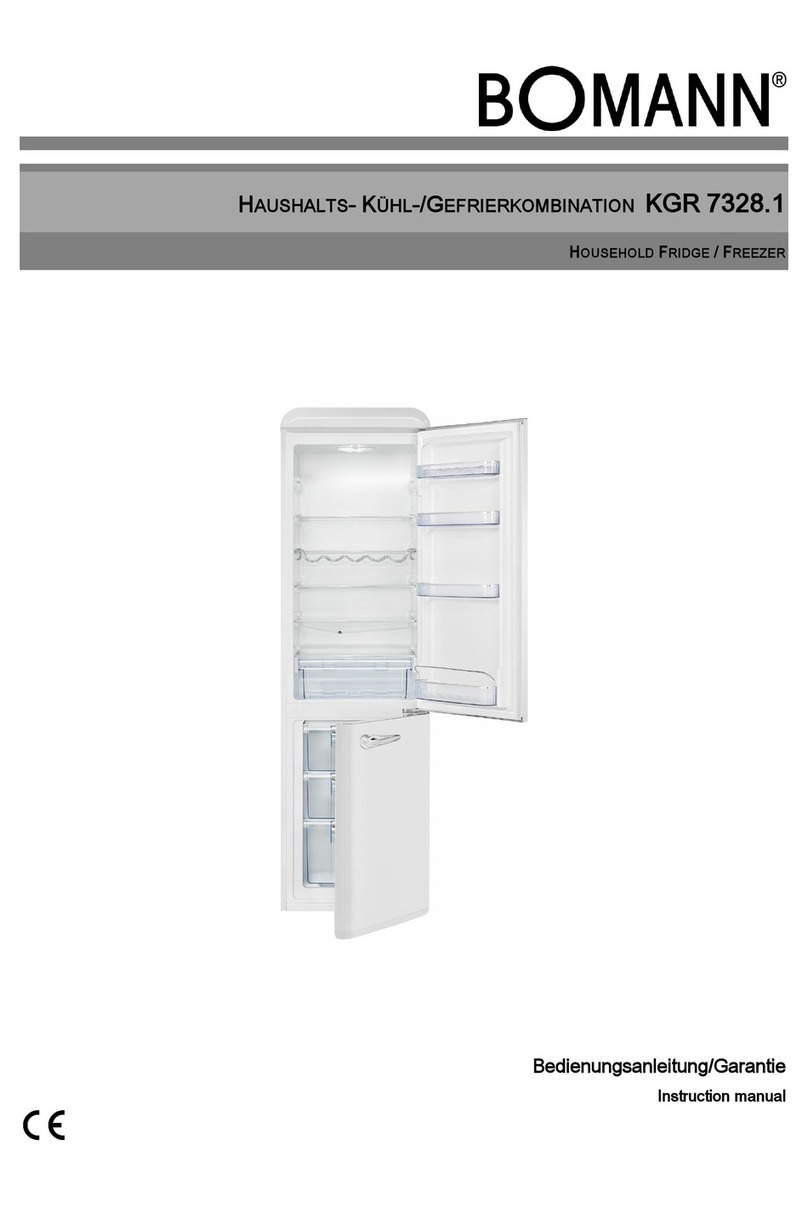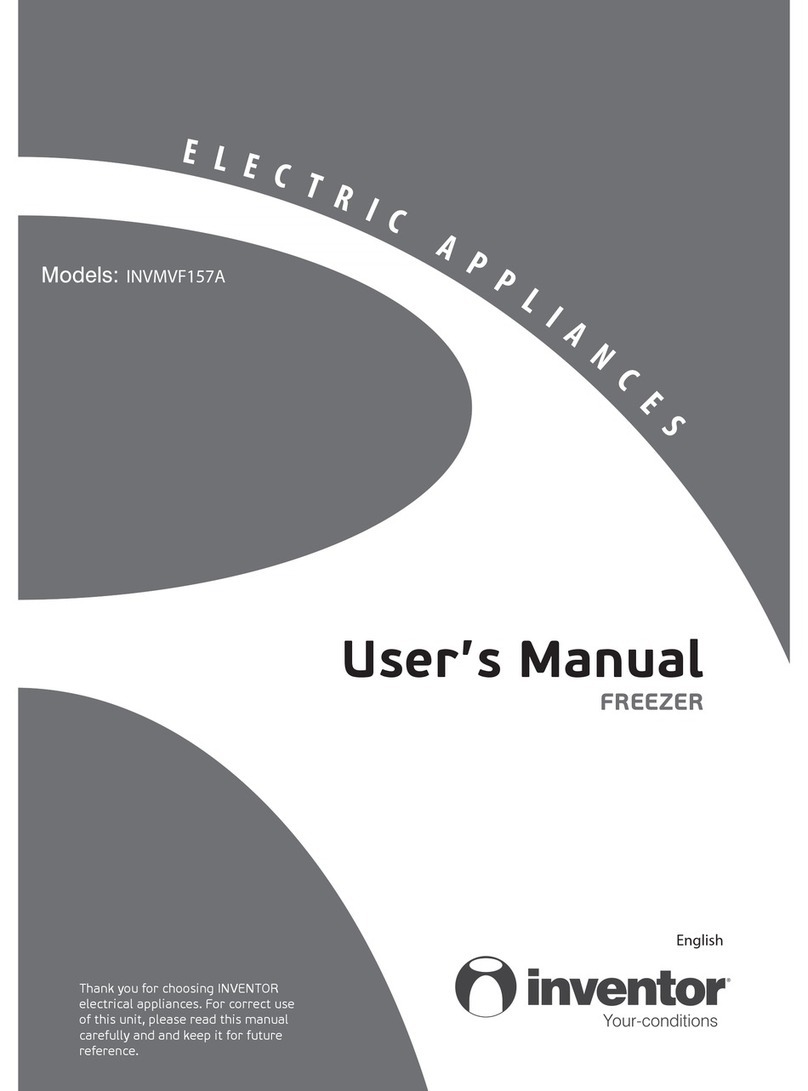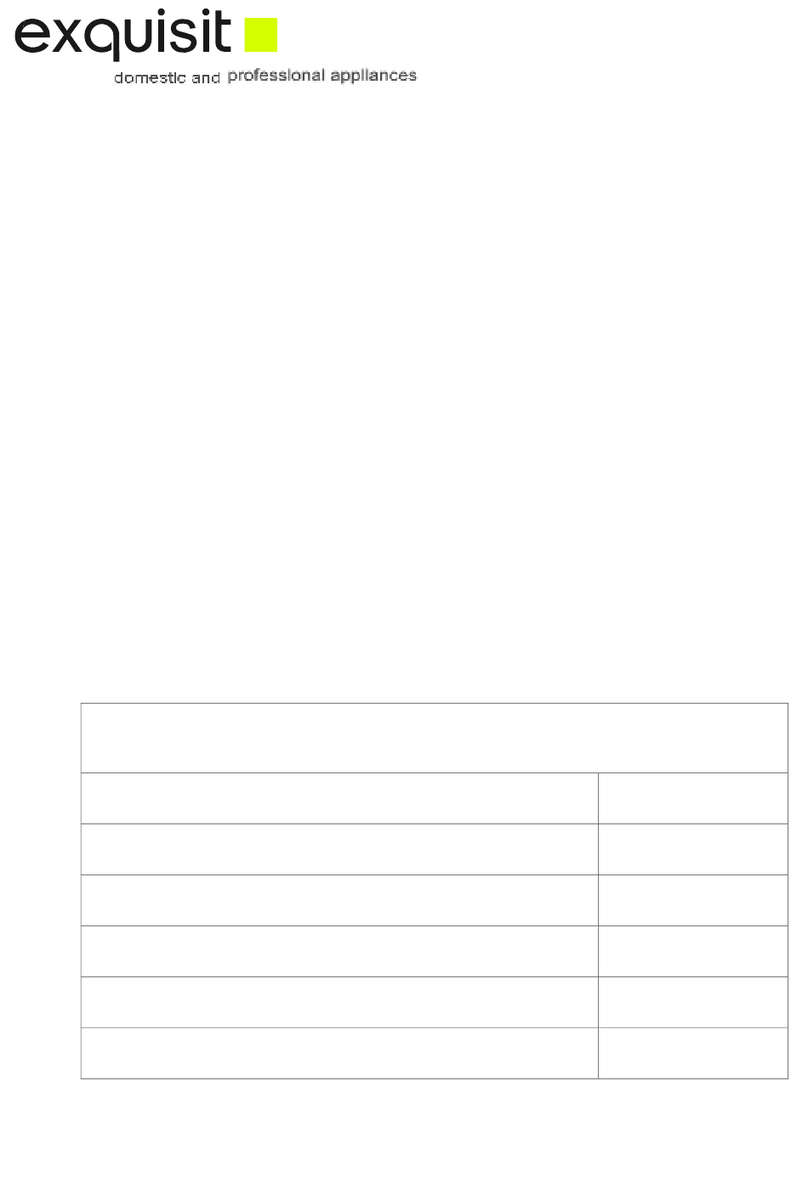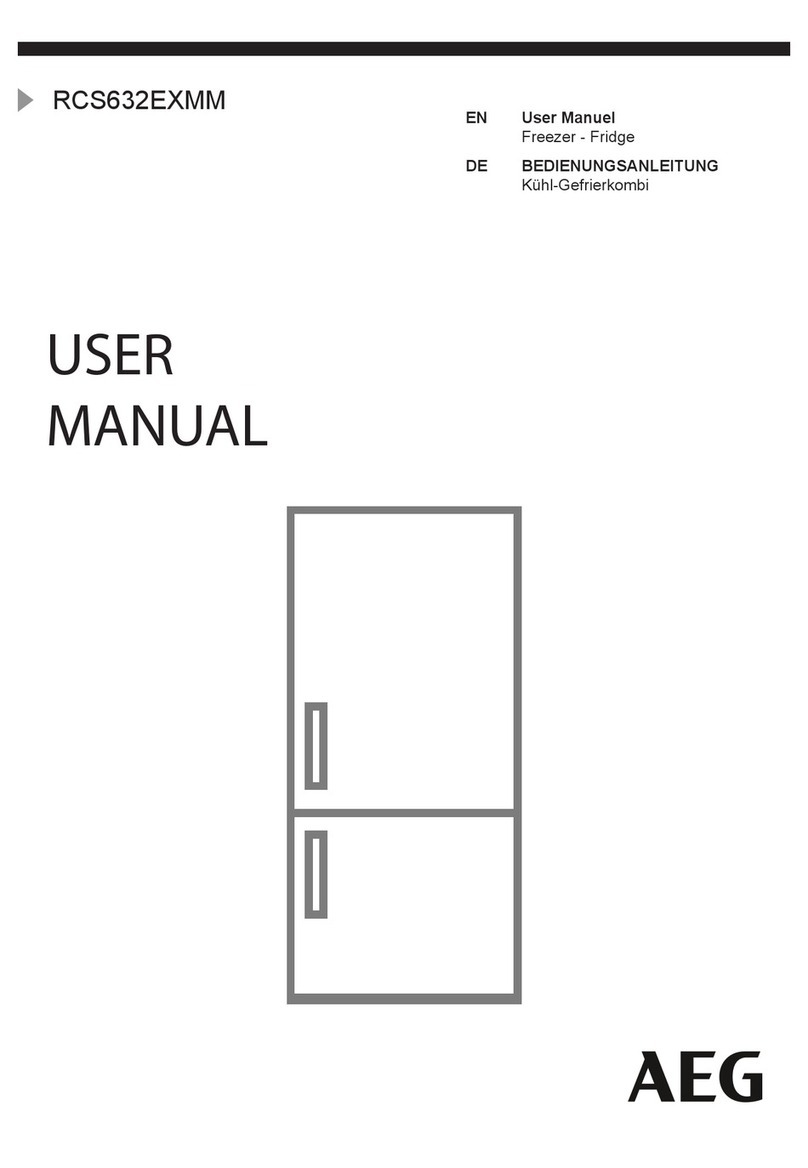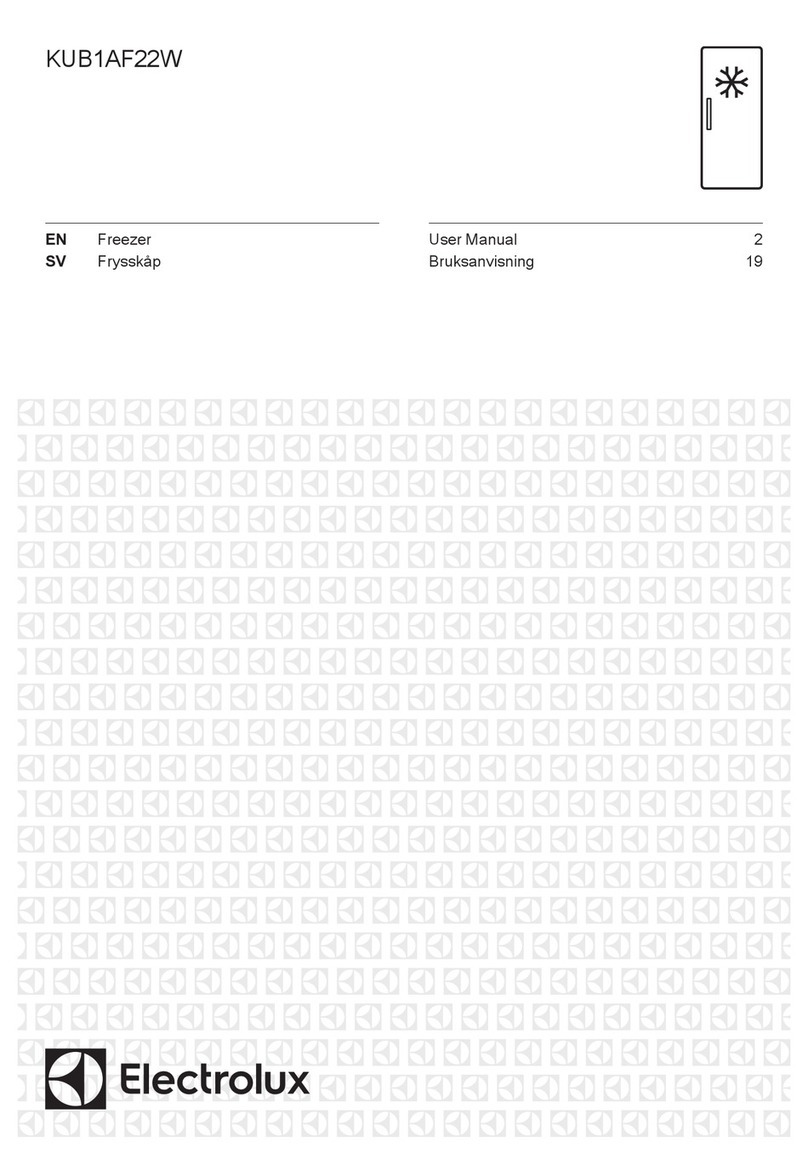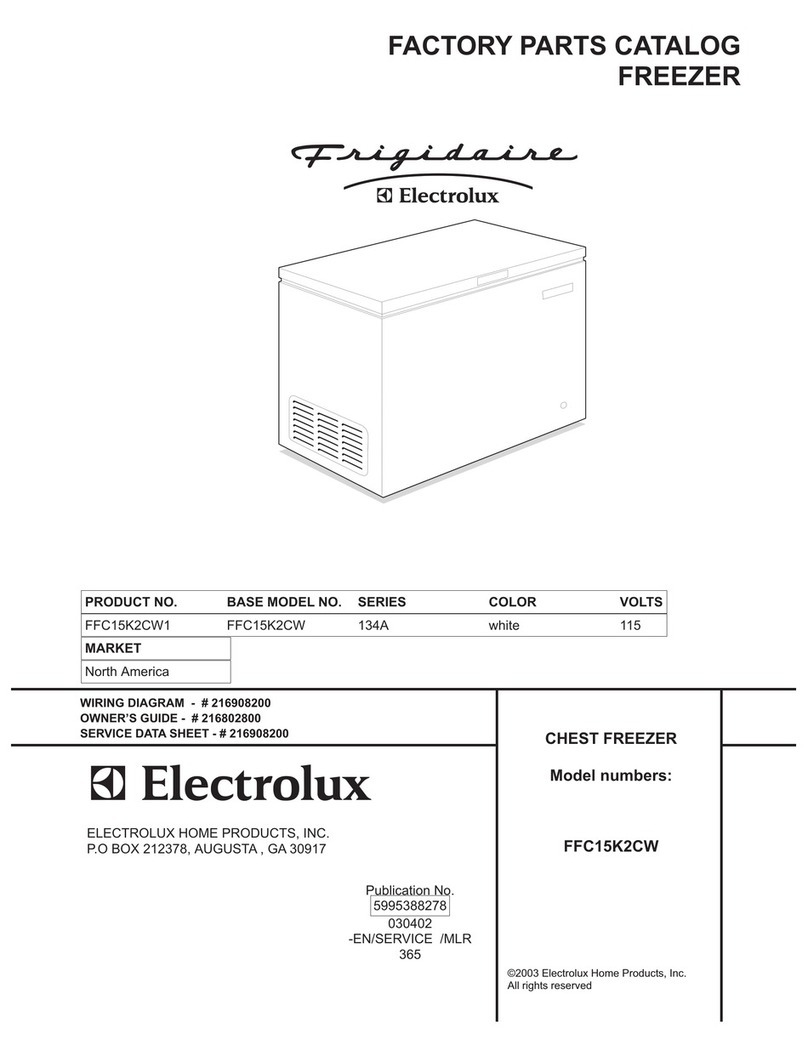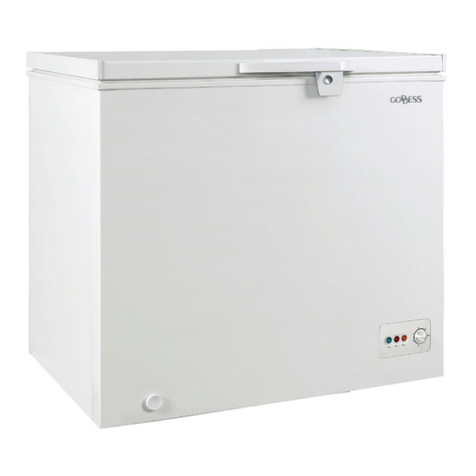J&E Hall JCC3 User manual

JCC3
CELLAR AND PRODUCT COOLERS
ISSUE: 01.06.2023
CELLAR COOLER RANGE
TECHNICAL MANUAL
R448A/R449A

Issue: 01.06.2023 Page II
IMPORTANT!
READ BEFORE PROCEED!
GENERAL SAFETY GUIDELINES
This guideline is intended for users to ensure safe installation, operation and maintenance of J & E Hall Cellar and Product
Coolers. This guideline is not intended to replace the system expertise available from the system manufacturers.
This equipment is a relatively complicated apparatus. During installation, operation, maintenance or service, individuals may be
exposed to certain components or conditions including, but not limited to refrigerants, materials under pressure, rotating
components, and both high and low voltage. Each of these items has the potential, if misused or handled improperly, to cause
bodily injury or death. It is the obligation and responsibility of operating/service personnel to identify and recognize these
inherent hazards, protect themselves, and proceed safely in completing their tasks. Failure to comply with any of these
requirements could result in serious damage to the equipment and the property in which it is situated, as well as severe personal
injury or death to themselves and people at the site.
This document is intended for use by owner-authorized operating/service personnel. It is expected that these individuals possess
independent training that will enable them to perform their assigned tasks properly and safely. It is essential that, prior to
performing any task on this equipment, this individual should have read and understood this document and any referenced
materials. This individual shall also be familiar with and comply with all applicable governmental standards and regulations
pertaining to the task in question.
SAFETY SYMBOLS
The following symbols are used in this document to alert the reader to specific situations:
WARNING
Warning! Risk of serious injury or
death to person!
CAUTION
Caution! Danger which can lead to
serious damages!
NOTICE
Notice! Risk of damage to equipment!
NOTICE
Disposal requirement
Your refrigeration product is marked with this symbol. This means that electrical and electronic products shall
not be mixed with unsorted household waste. Do not try to dismantle the system yourself: the dismantling of
the refrigeration system, treatment of the refrigerant, of oil and of other parts must be done by a qualified
installer in accordance with relevant local and national legislation. Refrigeration equipment must be treated
at a specialized treatment facility for re-use, recycling, and recovery. By ensuring this product is disposed of
correctly, you will help to prevent potential negative consequences for the environment and human health.
Please contact J & E Hall for more information.

Issue: 01.06.2023 Page 3
Contents
NOMENCLATURE.............................................................3
Figure 1: Product Nomenclature ...............................3
PRODUCT FEATURES .......................................................3
SPECIFICATIONS ..............................................................4
Table 1: Capacity Data ..............................................4
Table 2: System Data ................................................4
Table 3: Unit Dimensions and Weights .....................4
Table 4: Electrical Data and Requirements ...............5
HEALTH AND SAFETY.......................................................5
GENERAL INFORMATION.......................................................5
INSTALLATION.................................................................6
UNIT LOCATION AND FIXING..................................................6
Figure 2: Positioning of Condensing Unit ..................6
Figure 3: Air Circulation for Condenser .....................6
Figure 4: Installation Clearance (Outdoor Unit) ........6
Figure 5: Installation Clearance (Indoor Unit)...........7
FIELD PIPING......................................................................7
Figure 6: Piping Layout for Outdoor Above Indoor ...7
Figure 7: Piping Layout for Outdoor Below Indoor....8
PRESSURE TESTING..............................................................8
Table 5: Maximum Working Pressure .......................8
EVACUATION &CHARGING...................................................8
DRAINAGE.........................................................................9
Figure 8: Drain Fitting Assembly ...............................9
ELECTRICAL........................................................................9
COMMISSIONING............................................................9
SERVICE & MAINTENANCE ............................................10
F-GAS REQUIREMENT....................................................10
Table 6: Leak Inspection Frequency ........................11
TECHNICAL INFORMATION............................................11
ELECTRONIC CONTROLLER ..................................................11
Figure 9: Temperature Controller XR02CX ..............11
FAN SPEED CONTROLLER.....................................................12
Figure 10: Fan Speed Controller (Aspen FP2094) ....12
Figure 11: Sensor Location ......................................12
Figure 12: Wiring Diagram Outdoor Unit Integrate
FSC...........................................................................12
APPENDIX .....................................................................13
Figure 13: Dimension (Indoor Unit).........................13
Figure 14: Dimension (Outdoor Unit)......................13
Figure 15: Wiring Diagram (Indoor Unit) ................14
Figure 16: Wiring Diagram (Outdoor Unit) .............14
Figure 17: P&I Diagram for System.........................15
Table 7: Parameters (Controller XR02CX) ...............16
Table 8: Trouble Shooting .......................................17
Figure 18: Declaration of Incorporation (Outdoor
Unit) ........................................................................20
Figure 19: Declaration of Incorporation (Indoor Unit)
................................................................................21
Figure 20: EU Declaration of Incorporation (Outdoor
Unit) ........................................................................22
Figure 21: EU Declaration of Incorporation (Indoor
Unit) ........................................................................23
Nomenclature
Figure 1: Product Nomenclature
Product Features
J & E Hall Cellar and Product Cooler is a single split
refrigeration equipment consisting of indoor and outdoor
unit integrated with capillary (metering device). The
equipment is connected via copper pipes (not supplied) and
needs to be charged with R448A or R449A at field, to
cool and maintain a storage space temperature range
down to +4°C and up to +16°C. This range of temperature
makes it suitable for preservation of beers, wines, flowers,
fruit, vegetables etc.
Main features of the indoor and outdoor listed below:
The indoor unit consist of:
•6 fins/inch Al-Cu evaporator coil
•AC axial fan with run capacitor
•Digital thermostat with off cycle defrost
•Low pressure protection switch
•Polyester powder coated steel casing
•Accessories: 1”-14UNF drain pipe fitting
And the outdoor unit consist of:
•Single phase rotary compressor with
Permanent Split Capacitor (PSR wiring)
•AC axial fan with run capacitor
•Al –Cu condenser with inner groove 7mm
•Manual reset high pressure safety switch
(cartridge type)
•Acoustic insulation on compressor
•100 % molecular sieve core filter drier
•Capillary throttling device.
•Service valves with braze connection
Indoor Unit
Outdoor Unit
Product Type
JCC: J& E Hall Cellar Cooler (Indoor
Unit)
Nominal Cooling Capacity(kW)
25: 2.5kW
BOMVariance
E: Electronic Controller without TXV
EV: Electronic Controller with TXV
25 EJCC -3
Version
3: Capacity Rated for R448A
Product Type
J: J & E Hall Cellar Cooler (Outdoor Unit)
Nominal Cooling Capacity (kW)
26: 2.5kW
BOM Variance
26 CJ LC6
Refrigerant
6: R448A/R449A
Power Supply
V1: 230V/1phase/50Hz
V1
Throttling Device
LC: Capillary Tube

Issue: 01.06.2023 Page 4
Specifications
Table 1: Capacity Data
System
Indoor + Outdoor
Cooling capacities in kW at 32°C ambient temperature(1)
4°C (2)
6°C
8°C
10°C
12°C
12.7°C
14°C
16°C
JCC3-25E + J6LC26CV1
2.41
2.50
2.59
2.67
2.76
2.79
2.85
2.94
JCC3-40E + J6LC41CV1
3.47
3.62
3.76
3.91
4.06
4.11
4.20
4.35
JCC3-55E + J6LC56CV1
4.63
4.87
5.10
5.33
5.56
5.64
5.79
6.03
Notes:
(1) Cooling capacity rated at standard pipe length 7.6m.
(2) Room temperature of +4 ⁰C is only applicable with pipe lengths not more than 15m.
Table 2: System Data
Unit Model
Cooling
Capacity
kW (2)
System Pipe
Sizes
Maximum
Pipe Run (3)
Unit
Airflows
Indoor
Air
throw
(4)
Noise
Levels
(1)
Recommended
base charge
Additional
charge (6)
R448A/R449A
Liquid
Gas
Length
Rise
m³/h
m
dB(A)
kg
TCO2
g/m
JCC3-25E
2.79
1/4"
1/2"
25m
5m
2560
8
48
n/a
n/a
n/a
J6LC26CV1
2070
n/a
26
1.30
1.80
12
JCC3-40E
4.11
1/4"
1/2"
25m
8m
2270
8
48
n/a
n/a
n/a
J6LC41CV1
2225
n/a
26
1.75
2.43
6
JCC3-55E
5.64
1/4"
5/8"
25m
8m
2475
8
45
n/a
n/a
n/a
J6LC56CV1
2984
n/a
31
2.20
3.05
15
Notes:
(1) Noise levels are sound pressure levels @ 10m free field
(2) Cooling capacities are nominal duties @ 12.7°C DB / 10°C WB and 32°C ambient
(3) The pipe length has include the rise (the rise indicated is not an additional to the length).
(4) Indoor unit air throw distance is based on final air velocity of 0.4m/s.
(5) For piping exceeds 15m, fan speed controller is recommended to be installed in outdoor unit.
(6) An additional charge is required for pipe lengths more than 7.6m.
For applications where:
•Back-to-back installation, at least 1.5-meter pipe run with loop (to damp vibration) is required to avoid sound of outdoor
unit transferred to indoor unit via connecting pipe.
•The system pipe run exceeds 15m up to the maximum of 25m, a fan speed controller (not supplied as standard) is
recommended to be fitted to the condensing unit. Refer Section Fan Speed Controller for details. This is to eliminate too low
evaporating temperature which cause formation of thick frost on evaporator coil.
Table 3: Unit Dimensions and Weights
Model
Unit Dimensions (mm)
Fixing Centres
(mm)
Unit
Weights
Packing Dimensions (mm)
Packing
Weights
Width (2)
Depth
Height
Width
Depth
kg
Width
Depth
Height
kg
JCC3-25E
865
372 (1)
489
745
n/a
31
968
534
517
37
J6LC26CV1
855
328
651
603
362
38
990
415
693
41
JCC3-40E
865
372 (1)
489
745
n/a
33
968
534
517
39
J6LC41CV1
855
328
651
603
362
42
990
415
693
46
JCC3-55E
904
370 (1)
546
826
n/a
38
1006
534
576
45
J6LC56CV1
855
328
753
603
362
46
990
415
793
50
Notes:
(1) Unit depth does not include fan motor depth - add 120mm
(2) Unit width does not include pipe services - add approximately 70mm

Issue: 01.06.2023 Page 5
Table 4: Electrical Data and Requirements
Model
*Indoor
*Outdoor
Outdoor Unit
Compressor
Fan/Unit
Power
Supply
Mains
Power
To
Interconnecting
Power Cable
+ Control
Cable(5)
Suggested
Fuse
Rating
PI (1)
RRC (2)
LRA (3)
MOC (4)
PI (1)
RRC (2)
Qty
(kW)
(A)
(A)
(A)
(W)
(A)
V/Ph/Hz
(A)
JCC3-25E
n/a
n/a
n/a
n/a
232
0.99
1
230/1/50
Indoor
3C2.5mm2+
2C1.0mm2
16
J6LC26CV1
1.01
4.3
30
6.0
80
0.35
1
JCC3-40E
n/a
n/a
n/a
n/a
236
0.96
1
230/1/50
Indoor
3C2.5mm2+
2C1.0mm2
20
J6LC41CV1
1.64
7.2
36
10.9
80
0.35
1
JCC3-55E
n/a
n/a
n/a
n/a
210
0.95
1
230/1/50
Indoor
3C4.0mm2+
2C1.0mm2
25
J6LC56CV1
1.99
9.2
42
13.5
120
0.52
1
Notes:
(1) PI: Power Input at nominal duties @ 12.7°C DB / 10°C WB and 32°C ambient
(2) RRC: Rated Running Current at nominal duties @ 12.7°C DB / 10°C WB and 32°C ambient
(3) LRA: Locked Rotor Amps rated at 230V, 50Hz
(4) MOC: Maximum Operating Current
(5) Control cable need to be drawn from two terminals of indoor unit to connect to the high-pressure switch at outdoor unit for
compressor protection. Please refer to Figure 15 and Figure 16 on page 14 for wiring connections.
Health and Safety
Only a qualified refrigeration engineer, who
is familiar with refrigeration systems and
components including all controls, should
perform the installation and start-up of the
system. To avoid potential injury, use care when working
around coil surfaces or sharp edges of metal cabinets. All
piping and electrical wiring should be installed in
accordance with all applicable codes, ordinances, and
local by-laws.
General information
Before Installation
•Ensure the units received are the correct models for the
intended application.
•Ensure the refrigerant, voltage and MWP are all
suitable for the proposed application.
•Check there is no damage to the units. Any damage
should be reported to the supplier immediately.
•Check that the proposed equipment locations are
suitable and provide adequate support for the weight
of the units.
Offloading and Lifting
•Whenever a unit is lifted, it should be from the base
and, where possible, all packing and protection is kept
in position.
•If lifting equipment is required, ensure that it is suitable,
certificated, and that the operators are qualified to
use it.
•When using a fork-lift or pallet truck to lift the unit, the
two support points should be sufficiently apart to give
stability when lifting and suitably placed to distribute
the load on the forks.
•If slings are used, care should be taken to ensure that
the slings do not crush the casework or coil.
•Do not drop the unit. Should this inadvertently happen,
it should be immediately unpacked and inspected for
damage.
During Installation and subsequent
maintenance
•Installation and maintenance are to be performed only
by qualified personnel who are familiar with local
codes and regulations and experienced with this type
of equipment.
•Safe working methods are identified, and operatives
should have suitable PPE.
•Ensure the working area has adequate ventilation
during brazing procedures.
•The units contain moving machinery and electrical
power hazards, which may cause severe injury or
death. Disconnect and shut off power before
installation or service of the equipment.
•Refrigerant release into the atmosphere is illegal.
Proper evacuation, recovery, handling, and leak testing
procedures must always be observed.
•Units must be grounded to the screw terminal labelled
•No maintenance work should be attempted prior to
disconnecting the electrical supply.
•The electrical covers and fan guards must remain
always fitted.
•Use of the units outside of the design conditions and the
application for which the units were intended may be
unsafe and be detrimental to the units, regardless of
short- or long-term operation.

Issue: 01.06.2023 Page 6
Installation
Unit location and Fixing
Both indoor and outdoor units must be level in all directions.
Outdoor
•The installer must fix the unit securely on installation
using the M8 bolt holes in the unit feet to prevent
instability from accidental contact.
•It is recommended to install the outdoor unit on rubber
grommet or vibration dampers.
•The units are not designed to withstand loads or stress
from other equipment or personnel. Such extraneous
loads or stress may cause failure/leak/injury.
•The units are not designed to operate with any
restrictions such as heavy snowfall around them.
Additional measures (such as shielding of the units) shall
be implemented as required.
•To achieve maximum cooling capacity, the installation
location for the condensing unit should be carefully
selected.
•Install the outdoor unit in such a way so that hot air
ejected by the unit cannot be drawn in again (short
circuit of hot discharge air). Refer Figure 2.
Figure 2: Positioning of Condensing Unit
•Ensure that there is no obstruction to air flow into or out
of the unit. Remove obstacles which block air intake or
discharge. Refer Figure 3.
Figure 3: Air Circulation for Condenser
•Allow sufficient space for maintenance around the unit.
Refer Figure 4.
•The location must be well ventilated, so the unit can
draw in and distribute plenty of air thus lowering the
condensing temperature.
•To optimize the unit running conditions, the condenser
coil must be cleaned at regular intervals.
Special attention should be given to an
outdoor unit installed near to the sea as this
can reduce unit lifespan due to corrosion of
metal parts.
Indoor
•The indoor units can be mounted directly to a wall or to
the ceiling utilizing the fixing holes on the rear of the
unit or on the top of the unit. No additional brackets
are required.
•A minimum 10mm rawl bolt type fixing is required with
a large steel washer to bear the indoor unit weight. It
is important to ensure that the wall/ceiling can
withstand the unit weight and that all fixings are
secure.
•Position the indoor unit where the optimum airflow can
be achieved. Avoid locating in corners or in alcoves
which may restrict airflows.
•Avoid mounting indoor directly over door openings. It is
recommended to locate the indoor opposite door
openings to reduce infiltration and the amount of
warm, humid air drawn into the cold room. Also, to
locate indoors so that the distance to the opposite wall
does not exceed the unit's rated air throw distance.
•The installation location should allow sufficient space
for air flow and maintenance around the units. Refer
Figure 5.
Figure 4: Installation Clearance (Outdoor Unit)
OBSTACLE
OBSTACLE
AIR
INLET SERVICE
SPACE
OBSTACLE
OBSTACLE
AIR
INLET
AIR
DISCHARGE
CD
AB
Minimum Distance
Indicator
300 mm
A
1000 mm
B
300 mm
C
500 mm
D
✓
✓
X
X

Issue: 01.06.2023 Page 7
Figure 5: Installation Clearance (Indoor Unit)
Field piping
Pipe sizes and maximum lengths/heights
should be strictly as per the information
given on Table 2. All local codes of practice
must be observed in the installation of
refrigerant piping.
To ensure satisfactory operation and performance, the
following points should be noted for field piping
arrangements:
•Pipework routes must be as simple and as short as
possible.
•Use of incorrect pipe sizes can affect system
pressures/temperatures and gas velocity for proper oil
return.
•Avoid low points on pipework where oil can
accumulate.
•Use only clean, dehydrated refrigeration grade
copper tube with long radius bends.
•When brazing use brazing filler alloys containing
phosphorus such as BCuP-7 without flux for joining
copper tubes.
•Run braze without over filling to ensure there is no
leakage into the tube.
•To prevent oxidization, blow oxygen free nitrogen
through pipework when brazing.
•Protect the casing of the unit when brazing connections.
•Install insulation with a minimum wall thickness of 3/8”
on both liquid and suction lines.
•Adequately support all pipe work at a maximum of 2-
meter intervals.
•In vertical pipework, the use of U-trap is often
required. This suction riser must always be fitted with a
U-trap at the bottom and a P trap at the top and
never be higher than 4m unless a second U-trap system
is fitted. Maximum rise on Table 2 must be followed,
limited by compressor ability to handle pressure drop.
Refer Figure 6.
•Field piping for outdoor unit located below indoor unit:
Inverted P-trap is necessary to prevent refrigerant
from draining into the compressor during off-cycle.
Refer Figure 7.
•One of the main factors affecting equipment reliability
and compressor service life is refrigeration circuit
contamination. During installation, circuit contamination
can be caused by:
•Brazing & Welding Oxides
•Filings & Particles from de-burring
pipework
•Brazing Flux
•Moisture & Air
Figure 6: Piping Layout for Outdoor Above
Indoor
AIR
INLET AIR
INLET
Min. 1.8m from floor
OBSTACLE
FLOOR
AIR
THROWN
Min. 1.5m from
any obstacle
0.5m
0.5m
WALL
INDOOR
UNIT
OUTDOOR
UNIT
MAX. 4m MAX. 4m
8 TO 12 m/s
U-TRAP AS SHORT AS POSSIBLE
2cm/m SLOPE,
4m/s OR MORE
SUCTION LINE
2cm/m SLOPE, 4m/s OR MORE
RISE (REFER TABLE 2)
U-TRAP AS
SHORT AS
POSSIBLE
INVERTED P-TRAP
LIQUID MIXTURE LINE

Issue: 01.06.2023 Page 8
Figure 7: Piping Layout for Outdoor Below
Indoor
Pressure testing
Never use oxygen, dry air, or acetylene for
pressure testing of the system as these may
form an inflammable mixture.
The outdoor unit is NOT pre-charged with
refrigerant from factory.
Refer Table 2 for the recommended base
charge.
•Both the indoor and outdoor units are pressure tested
in the factory prior to dispatch. All units come with a
holding charge of oxygen free nitrogen ~2barg.
Remove the holding charge indication tag which is tied
on the service valve of outdoor unit before installation.
•Once the pipework installation is complete, it should be
pressure tested for the leaks prior to evacuation.
•A pressure leak test should be carried out using oxygen
free nitrogen (OFN). A calibrated nitrogen pressure
regulator must always be used. Before starting any
pressure testing, ensure the area surrounding the system
is safe, inform relevant personnel and fit warning signs
indicating high pressure testing. Also, use correct PPE as
required.
A simple procedure for testing is as follows:
▪Connect a pressure hose from the regulator to the
schrader connection on the service port (both suction
and liquid line) on the outdoor unit.
▪Pressurize the system slowly up to 3 bar (45 psi) for 5
minutes and check for any signs of leakage.
▪Increase pressure slowly up to 10 bar (150 psi) for 5
minutes and check for any signs of leakage.
▪Increase pressure slowly up to 20 bar (300 psi) and
check for any signs of leakage. Leave system under
pressure for 24 hours.
▪Listen for any possible leaks and check all joints with
bubble spray. If any leaks are discovered, release
pressure slowly from the system until empty, repair
leak and then repeat pressure testing procedure.
Never attempt to repair a leak on a pressurized
system.
A strength test should also be incorporated according to
local regulations. Never exceed maximum working
pressures shown in Table 5. Failure to obey the limit will
cause premature failure on the pressure safety device.
Table 5: Maximum Working Pressure
High Side, barg (psig)
Low Side, barg (psig)
28 (405)
19 (275)
Once testing has been completed satisfactorily, release the
pressure from the system gradually and safely to external
atmosphere.
Evacuation & Charging
Moisture prevents proper functioning of the
compressor and the refrigeration system.
Ensure that a good quality vacuum pump is
used to pull a minimum vacuum of 250
microns (0.25 torr).
Once pressure testing has been completed, the system can
now be evacuated to remove air and any moisture from the
piping. This can be done as follows:
•Ensure any nitrogen charge is safely released from the
system.
•Connect a gauge manifold to the schrader connection
on the service valve on the outdoor unit.
•Connect a vacuum pump and vacuum gauge to the
system.
•Evacuate the system until vacuum is below 250 microns
(0.25 torr).
A triple evacuation procedure is
recommended for all new systems or where
moisture is suspected.
•Once the system is isolated and the vacuum pump is
switched off, any rise in pressure indicates that either
there may be a leak in the system or moisture is still
present. In this case, recheck the system for leaks, repair
as necessary, and then repeat the evacuation
procedure.
•Once evacuation is completed satisfactorily, the vacuum
pump and vacuum gauge can be removed. At this point,
the refrigerant charge can be added to the system as
required. Refrigerant blend must be charged in liquid
form to avoid change of chemical properties.
•Ensure an adequate liquid charge (4~5barg) has been
introduced to the high side of the system before
starting the compressor.
•The remaining charge is slowly throttled into suction
side until the installation has reached a level of stable
nominal condition during operation. Charging liquid
into the suction side of the system should ONLY be
OUTDOOR
UNIT
INDOOR
UNIT
INVERTED P-TRAP
SUCTION LINE
LIQUID MIXTURE LINE
2cm/m SLOPE, 4m/s OR MORE

Issue: 01.06.2023 Page 9
done with a metering device. Ensure a minimum
operating pressure 0.5 barg is maintained when
adding refrigerant to the suction side, otherwise
overheating of the compressor may occur. Use
calibrated weighing scales to add base refrigerant
plus any additional charge required which specified in
Table 2.
•Stop the filling once obtain the correct charge amount
(at this point, there is sufficient suction superheat and
liquid subcooling), remove the cylinder from circuit.
Drainage
The evaporator drain pan fitting is supplied
loose and must be fitted on site.
Correct fitting is vital to ensure leak free operation. The lock
nut and the aluminium washer on the drain fitting MUST be
fitted the right way around; otherwise, it will not tighten
against the drip tray. One side of the nut has an angled
recess –this must be facing towards the drip tray. The fitting
does not require any sealant, but a small amount of silicon
sealant can be applied between the flared face of the fitting
and the drip tray if so desired.
The accessories bag is tied to the indoor unit’s fan guard and
consists of:
•instruction manual,
•1pcs aluminum alloy drain fitting 1”-14UNF male
thread,
•1pcs hexagon locknut and
•1pcs aluminium washer
To install the drain fitting, firstly unscrew the drain pan from
the indoor unit. Locate the drain fitting into drain pan, insert
washer and followed with locknut to secure the drain fitting
to the drain pan. Then refit the drain pan to the unit. Follow
Figure 8 to install the drain fitting in the correct way.
Figure 8: Drain Fitting Assembly
The locknut only requires hand tightening and then pinching
up with a spanner. Do not over tighten, else the threads may
strip from the nut and damage the tray.
Recommended minimum drainpipe diameter is 25mm or 1”.
The drainpipe material could be either copper or plastic. It
is not recommended to use flexible hose as it tends to kink
easily which might cause blockage and water to back up in
the unit.
Electrical
The mains electrical supply to the indoor unit
must be via a suitably rated isolator and
motor rated circuit breaker or fuse. There is no
isolator fitted to either the indoor or the
outdoor unit. The rocker switch on the front of the indoor
unit is for isolating the indoor fan and electronic controller
only.
J & E Hall cellar cooler systems require a 230 volt / 1 phase
/ 50Hz supply which must include a Neutral and Earth. They
are not suitable for any other supply voltages (other than a
deviation of +/- 10% of the above values) and are not
suitable for 60 Hz supplies.
•Cable type and sizing must be selected for the
application and the electrical installation should
conform to the current local standards. All indoor and
outdoor units are Single Phase.
•Cables to the indoor unit should be routed through the
‘U’ shaped cut-out in the bottom of the removable air
grille at the side of the unit and into the rear of the
electric box.
•Cables to the outdoor unit should be routed under the
plastic pipe / electrical connection cover on the end of
the unit.
•The interconnecting cable between the indoor and
outdoor unit should be 3 cores for power supply and 2
cores for control circuit connected to high pressure
switch.
•Connect the mains supply and interconnecting cables as
per the wiring diagrams in Figure 15.
•Access to the electrical terminals and components on
the indoor unit is via the removable cover plate on the
front of the unit. Removal of the cover plate gives
access to the outdoor unit contactor, the terminal block
as well as the electronic controller and rocker switch
connections.
Commissioning
To gain access to the electrical box on the indoor and
outdoor unit, isolate the power supply to the outdoor unit
and indoor unit by turning the remote motor rated circuit
breaker to the OFF position.
To access electrical box on the outdoor unit: Loosen the
screws from the plastic valve cover, slightly slide downward
to remove the plastic cover.
To access electrical box on the indoor unit: Loosen the
screws from the L shaped window panel.
Pre startup checks
Before starting the system, the following checks should be
carried out as a minimum:
•Check electrical supply is correct and all connections
are sound.
•All moving parts are free, and guards are fitted.
•All valves are in correct operating position.
•Refrigerant type is correct and the required charge
amount by referring to Table 2.
•Gauge manifold connected to both low and high sides
of system.

Issue: 01.06.2023 Page 10
Before starting the system, ensure that all
electrical connections are correctly made and
tight, service ports are in the correct position
and all covers and guards are fitted.
Unit startup
•Switch on the power at the mains isolator and then
switch on the rocker switch on the front of the indoor
unit.
•Set the required cold room temperature on the
electronic controller and check the system parameters
in the controller as required (the controllers are pre-
programmed in the factory to suggested settings).
•Run the system to the required temperature and check
system pressures, gas charge and running currents of
motors to ensure correct operation.
•Carry out a manual defrost (press the defrost button on
the controller for more than 2 seconds) to ensure the
defrost period is adequate to clear any frost build up
on the evaporator coil.
•Carry out final leak test and ensure all covers are
fitted and securing screws are tightened.
•Log all information along with system model and serial
numbers for future reference.
•Ensure that the customer / responsible person is
provided with basic operating instructions and where
electrical isolators are situated in case of emergency.
An anti-short cycle timer is built into the
indoor controller to prevent the compressor
from stop/starting too quickly, which can
result in the compressor tripping on its
internal overload. If the overload trips,
please allow time for it to cool down and auto reset
before restarting.
Service & Maintenance
Warning! –Disconnect the mains electrical
supply before servicing or opening the units.
The units are designed to give long life
operation with minimum maintenance. However, it should be
routinely checked, and the following service schedule is
recommended under normal circumstances:
1. Indoor and Outdoor units –Inspect at regular intervals
•Check for refrigerant leaks on all joints and
fittings.
•Check mountings for tightness and wear.
•Inspect pipework for any damage.
•Check all electrical connections.
•Ensure that no abnormal noise or vibration is
detected during the test run.
2. Condenser & Evaporator Fan Motors & Blades –Clean
and inspect at regular intervals
•Check for abnormal noise, vibration, and fan
imbalance.
•Ensure that the fan motors are clean and spin
freely.
•Check that the fan blades are clean and free from
restriction and damage/imbalance.
•Note: The Fan Motors are pre-lubricated, and
factory sealed so no maintenance is necessary.
3. Condenser & Evaporator Coils –Clean and inspect at
regular intervals
•Check and remove the dirt and debris between
the fins using a soft brush and/or a suitable
chemical coil cleaner then rinse with clean water.
•Check and remove any obstacles that may hinder
the airflow through the coils.
•Repair any damage to fins and ensure any guards
are fitted correctly.
•DO NOT USE HIGH PRESSURE WASHERS ON
COILS –THEY DAMAGE THE FINS.
4. Controls
•Check controller settings and operation.
•Check calibration of temperature probe reading.
5. Power Supply –Inspect at regular intervals.
•Check the running current and voltage for the units.
•Check the electrical wiring and tighten the wires
onto the terminal blocks if necessary.
6. Refrigerant Charge
•Check the refrigerant charge by ensuring that the
system is operating correctly, and the system
pressures are as expected.
•Carry out a full leak test.
7. Unit decommissioning and disposal
•At the end of the system’s useful life, a suitably
qualified engineer should decommission it. The
refrigerant and compressor oil are classed as
hazardous waste and as such must be reclaimed
and disposed of in the correct manner, including
completion of waste transfer paperwork. The
system components must be disposed of or
recycled as appropriate in the correct manner.
F-Gas Requirement
The equipment covered in this Technical Manual relies on
fluorinated greenhouse gases R448A and R449A for their
functioning.
J & E Hall Cellar and Product Cooler is a non-hermetically
sealed system where the outdoor unit is designed to use
with R448A and R449A. The outdoor and indoor unit
models come from the factory pressurized with OFN
(Oxygen Free Nitrogen) only. The system had to be
charged with the recommended charge specified in Table 2.
In F-Gas Regulation EU 517/2014, this type of system only
be able to be installed by engineers who hold an F Gas
qualification.
The requirement for leak testing is based on the charge size
in tonnes of CO2equivalent specified in below table.
Starting 1st January 2017, the requirement for leak
detection and maintaining system logs changes from 3kg
HFC to 5 tonnes CO2 equivalent.

Issue: 01.06.2023 Page 11
Table 6: Leak Inspection Frequency
System Charge
(Tonnes CO₂
Equivalent)
Leak Inspection Frequency
3.6 to 36.0 kg R448A
3.6 to 35.8 kg R449A
•At least once every year.
(5 to < 50 TCO2eq)
•At least once every 2 years
if a fixed leak detection
system is fitted.
A refrigerant charge label is supplied with each outdoor
unit. The refrigerant charge for the system must be filled on
the label along with the TCO2eq value with indelible ink
and must be adhered in the proximity of the product
charging port.
Total system charge = Recommended charge for pipe
length 7.6m and below + Additional refrigerant charge
added at site (for pipe length exceed 7.6m)
Enter TCO2eq value from calculation:
𝑇𝑜 𝑐𝑎𝑙𝑐𝑢𝑙𝑎𝑡𝑒 𝑇𝐶𝑂2 𝐸𝑞 𝑣𝑎𝑙𝑢𝑒
=𝑅𝑒𝑓𝑟𝑖𝑔𝑒𝑟𝑎𝑛𝑡 𝐶ℎ𝑎𝑟𝑔𝑒 (𝑘𝑔𝑠) × 𝑅𝑒𝑓𝑟𝑖𝑔𝑒𝑟𝑎𝑛𝑡 𝐺𝑊𝑃
1000
Technical Information
Electronic Controller
The indoor unit is equipped with a controller to control the
room temperature based on the setpoint temperature. The
controller parameter could be viewed and changed as
described in the section below.
Figure 9: Temperature Controller XR02CX
To check the setpoint temperature:
•Press and release the SET button.
To change the setpoint temperature:
•Press the SET button for more than 3 seconds
•The setpoint value is displayed and the °C or °F led
starts flashing.
•To change the setpoint value press the ▲or ▼button
within 10 seconds.
•To retain the new setpoint press the SET button again
or wait 10 seconds.
To start a manual defrost:
•Press the defrost button for more than 2 seconds.
To lock and unlock keyboard:
•Press the ▲and ▼buttons together for more than 3
seconds.
•When The ‘OF’ message displayed, the keyboard is
now locked.
•When the ‘ON’ message is displayed, the keyboards
will be unlocked.
To change a parameter value (selected parameters):
•Enter the programming mode by pressing the SET and
the ▼buttons together for more than 3 seconds (°C or
°F LED starts blinking). The first parameter (Hy) is
displayed.
•Press the SET button to display the parameter value.
•Use the ▲and ▼buttons to change the parameter
value.
•Press the SET button to store the new value and move
to the next parameter.
•To exit the programming mode, press the SET and ▲
buttons together or wait 15 seconds without pressing a
button.
To enter the hidden parameter menu (full parameter list):
•Enter the programming mode by pressing the SET and
▼buttons together for 3 seconds (°C or °F LED starts
blinking).
•Release the buttons, and then press the SET and ▼
buttons for more than 7 seconds. L2 will be displayed
followed by the first parameter (Hy). You are now in
the hidden menu.
•Select the required parameter.
•Press the SET button to display the parameter value.
•Use the ▲and ▼buttons to change the parameter
value.
•Press the SET button to store the new value and move
to the next parameter.
•To exit the programming mode, press the SET and ▲
buttons together or wait 15 seconds without pressing a
button.
Ref. GWP Charge (kg) TCO2Eq.
R448A 1387
R449A 1397

Issue: 01.06.2023 Page 12
Fan speed controller
The fitting of a fan speed controller is compulsory for
applications where the system pipe run is longer than 15m.
Refer to Table 2.
Aspen Cooling Only model as shown in Figure 10, is
recommended to be installed on the outdoor unit to
regulate fan speed based on condensing temperature. The
fan speed controller could be obtained either from your
unit distributor or various refrigeration stockists.
Figure 10: Fan Speed Controller (Aspen FP2094)
Aspen FP2094 fan speed controller comes supplied with full
fitting and set-up instructions. Refer to Figure 12 and
instructions below for the field wiring:
•Find a suitable mounting point for the controller within
the outdoor unit casing and fix it securely. (Aspen
FP2094 is not waterproof and should be installed in
the electrical compartment of the condensing unit).
•Connect the thermal sensor to the terminals red/blue on
the controller and fix the sensor side to a bend of the
condenser coil in the middle between an entrance point
and outgoing point of the refrigerant tubing, refer
Figure 11. In case of any doubt, measure the
condensing temperature and select the point which is
closest to the saturation point.
•If possible, put a thermal paste on the sensor or isolate
it, to obtain the best measurements and working results.
•Remove the condenser fan Live wire (Black) from the ‘L’
connection on the unit and connect to ML on the FSC.
Remove the condenser fan Neutral wire (Blue) from the
connection at the compressor run capacitor and connect
to MN on the FSC.
•Make up a new wire to connect ‘L’ (on unit) to L (on
controller) and another new wire to connect ‘N’ (on unit)
to N (on controller). Provide a new Earth wire between
the unit and E on the controller.
•Tighten all wiring connections and secure all wires as
necessary. The wiring is now complete.
•Run the unit and adjust controller as per instructions to
give required condensing temperature (35°C~40°C).
Figure 11: Sensor Location
Figure 12: Wiring Diagram Outdoor Unit Integrate FSC
Min
Speed
Cooling
version only
Set
Point
N L E ML MN T2 T1
Temp
Red
Temp
Blue
NL 1 2
P>
S1PH
BLK BLK
FROM INDOOR UNIT
220-240V/~/50Hz
RESET
M1F
M
1~
C2
M1C
1~
RD
M
BLK
BLU
TSR
PE
C1
BLK
RD
BLU
PE
BLK
TO INDOOR
P3 P4
Q1R

Issue: 01.06.2023 Page 13
Appendix
Figure 13: Dimension (Indoor Unit)
MODEL
A
B
C
D
E
F
G
H
I
J
K
L
M
JCC3-25E
JCC3-40E
865
745
745
489
479
433
207
31
51
417
492
372
46
JCC3-55E
904
826
826
546
535
452
205
30
68
472
491
370
44
Figure 14: Dimension (Outdoor Unit)
MODEL
A
B
C
D
E
F
G
H
I
J
K
L
M
N
J6LC26CV1
J6LC41CV1
855
628
328
508/520
181/179
44/46
93
149
101
113
603
126
164
17/15
J6LC56CV1
855
730
328
513/520
182/179
44/46
93
149
101
113
603
126
164
17/15
MODEL
O
P
Q
R
S
J6LC26CV1
J6LC41CV1
49/34
23
362
73
75
J6LC56CV1
47/34
23
362
73
75

Issue: 01.06.2023 Page 14
Figure 15: Wiring Diagram (Indoor Unit)
Figure 16: Wiring Diagram (Outdoor Unit)
Manual reset on the cartridge type
high pressure switch is required
after the fault is removed.
INDICATOR
C1: FAN CAPACITOR
K1M: CONTACTOR
M1F: EVAPORATING FAN
S1PL: LOW PRESSURE SWITCH
S1S: ON/OFF SWITCH
- - - -: FIELD WIRING
MODEL C1 (uF)
JCC3-25/40/55E 6.0
C1
M1F
1~
M
K1M
1 3 5
22
21
42 6
CLL N CN P1
P<
A2
A1
BLU
BRN
C
LN
S1PL
BRN
P2
BLK
RD
K1M
E
P3
52
41
CLNROOM
1 2 3 4 6 7 8 9
BLK
HOT KEY XR02CX
S1S
BRN
BRN
BLU
BLU
240V~
RD
RD
BLK
BLU
RD
PLATE
WINDOW
CASING
POWER SUPPLY TO
OUTDOOR UNIT
INCOMING SUPPLY
220-240V/~/50Hz
SUPPLY
NOTE
(1)LINK WITH JABC:
REMOVE JUMPER WIRE
P2-P3, TO CONNECT
WIRE FROM TERMINAL
A, B OF JABC UNIT.
(2)LINK WITH
J6LC026/41/56CV1:
REMOVE JUMPER WIRE
P3-P4, TO CONNECT
WIRE FROM TERMINAL
1, 2 OF OUTDOOR
UNIT.
(3)LINK WITH
BSCU-30/35/40-M1/3:
BYPASS S1PL WITH
JUMPER WIRE CONNECT
TO P1-P2.
REMARK:
S1PL: 0.35/1.38barG
AUTO RESET
NOTE 1
BRN
P4
RD
NOTE 2
NOTE 3
LN
INDICATOR
C1: RUN CAPACITOR
C2: FAN CAPACITOR
M1C: COMPRESSOR
M1F: CONDENSER FAN
S1PH: HIGH PRESSURE SWITCH
Q1R: COMPRESSOR THERMOSTAT
- - - -: FIELD WIRING
MODEL C1 (uF) C2 (uF)
J6LC26CV1 50 3.0
J6LC41CV1 60 3.0
J6LC56CV1 50 3.5
N
L 1 2
P>
S1PH
BLK BLK
FROM INDOOR UNIT
220-240V/~/50Hz
NOTE
S1PH: 28/22barG MANUAL RESET
Q1R: 110/95°C AUTO RESET
RESET
M1F
M
1~
C2
M1C
1~
RD
M
BLK
BLU
CSR
PE
C1
BLK
RD
BLU
PE
BLK
TO INDOOR
P3 P4
Q1R

Issue: 01.06.2023 Page 15
Figure 17: P&I Diagram for System
JCC3-25E + J6LC26CV1
JCC3-40E + J6LC41CV1
JCC3-55E + J6LC56CV1
LEGEND
SERVICE VALVE
LOW PRESSURE SWITCH
HIGH PRESSURE
SWITCH
THERMISTOR
CHARGING PORT
CAPILLARY TUBE
ROTARY
COMPRESSOR
CONDENSER:
AIR-COOLED
FINNED TUBE HEAT
EXCHANGER WITH
AXIAL FAN
EVAPORATOR:
AIR-COOLED FINNED
TUBE HEAT EXCHANGER
WITH AXIAL FAN
PSL
SUCTION
VALVE
LIQUID
VALVE
INDOOR
(ROOM TEMPERATURE 4~16°C)
T
Refrigerant:
(1) R448A
(2) R449A
DWG NR: RJ7003010013992
OUTDOOR
(AMBIENT UP TO 38°C)
PSH
FILTER
DRIER
SYSTEM
PSL
PSH
T

Issue: 01.06.2023 Page 16
Table 7: Parameters (Controller XR02CX)
Label Description Range Default setting JEH Setting
Hy Differential 0.1 ~ 25°C / 1 ~ 45°F 2.0°C / 4°F 2.0°C
ot Probe calibration -9.9 ~ 9.9°C / -18 ~ 18°F 0.0 0.0
AC Anti Short Cycle Delay 0 ~ 50 minutes 1 3
CH Kind of Action (Cool / Heat) cL ~ Ht cL cL
rE Resolution (°C only): dE = decimal between -9.9 ~ 9.9°C; in = integer dE ~ in dE in
id Interval between defrost cycles 0 ~ 99 hours 8 6
Md Maximum defrost length 0 ~ 99 minutes 20 30
AU Maximum Alarm Temperature ~ 99°C / ~210°F 99°C / 99°F 99°C
AL Minimum Alarm Temperature -55°C / -67°F -55°C / -55°F -55°C
iP
Digital input polarity: oP = activated by closing the contact; cL = activated by opening the contact cL ~ oP cL cL
iF
Digital input configuration: EA = external alarm; EA message is displayed: bA = serious alarm; CA
message is displayed: do = door switch function: dF = defrost activation: Au = not used: Hc =
inversion of the kind of action
EA / bA / do / dF / Au / db /
Hc
EA EA
di
Digital input delay. With iF = EL or bA delay between the detection of the external alarm condition
and its signalling. With iF = do it represents the delay to activate the door open alarm
0 ~ 99 minutes 5 5
LS Minimum Set Point -55°C / -67°F -55°C / -55°F 4°C
US Maximum Set Point 99°C / 210°F 99°C / 99°F 16°C
od Output activation delay at startup 0 ~ 99 minutes 0 0
Cy Compressor on time faulty probe. Cy = 0 compressor always OFF 0 ~ 99 minutes 15 5
Cn Compressor off time faulty probe. Cn = 0 compressor always active 0 ~ 99 minutes 30 10
CF Measurement units: °C = Celsius; °F = Fahrenheit °C / °F °C °C
dY Display delay 0 ~ 15 minutes 0 0
dF
Display during defrost: rt = real temperature; it = start defrost temperature: St = SET POINT: dF =
label dF
rt / it / St / dF it it
Ad Temperature alarm delay 0 ~ 99 minutes 15 15
dA Exclusion of temperature alarm at startup 0 ~ 99 minutes 90 90
dC
Compressor and fan status when door open: no = normal; Fn = Fans OFF; cP = Compressor OFF; Fc =
Compressor and fans OFF
no / Fn / cP / Fc no no
rd
Regulation with door open: n = no regulation if door is opened; Y = when di is elapsed regulation
restarts even if door open alarm is present
n ~ Y Y Y
Pt Parameter code table Read Only - -
rL Firmware release Read Only
--
Parameter Menu (selected parameters)
Hidden Parameter Menu (Full list including above parameters)
Dixell XR02CX Parameters

Issue: 01.06.2023 Page 17
Table 8: Trouble Shooting
FAULT
POSSIBLE CAUSE
CHECK
SOLUTION
COMPRESSOR
Compressor will
not start
Power supply
Is power switched on?
If not - switch on
Phase and neutral present?
Check/rectify
Voltage within tolerance?
Check/rectify
Compressor contactor not
pulled in (contactor in
indoor unit)
Is there correct voltage to
contactor coil? (Terminals A1 &
A2)
If yes - coil faulty. Replace
contactor
If no - check for break in control
circuit
Is the controller calling for cooling?
(Cooling LED lit)
If yes - check for break in control
circuit
If no - is controller set correctly?
Is the controller on defrost?
(Defrost LED lit)
If yes - wait for defrost to finish
or terminate defrost and check
operation
Is there an alarm condition shown
on the controller display?
Refer to manual for alarm
identification and resolution
Has a safety switch tripped out?
Check cause and rectify
Compressor contactor
pulled in but compressor
not running
Is voltage being switched across
contactor? (Terminals L1 & T1)
If yes - check voltage present at
compressor terminals. If correct -
compressor may have tripped
internal overload or be faulty
If no. Replace faulty contactor
LP switch tripped (on
indoor unit)
Low pressure condition
Low refrigerant charge/icing of
evaporator coil/evaporator fan
failure/blockage in piping. Check
& rectify cause
Compressor internal
overload tripped
Is the correct voltage at
compressor terminals?
Compressor has overheated -
allow time for reset (up to 3
hours) and rectify cause
Faulty compressor run
capacitor
Check visual condition of capacitor
and check capacitance reading with
capacitor meter.
Replace capacitor as required
Motor windings faulty
Check resistances of windings
Windings that show open circuit
could be due to internal overload
trip. Wait for reset and recheck.
If continually open circuit - motor
faulty. Replace compressor.
Compressor seized
Does compressor attempt to start
but does not run correctly (makes
humming sound)? Are amps
equivalent to LRC rating?
If all electrical checks on
components as above are OK -
Change compressor
Compressor runs
but no effect on
suction/discharge
pressures
Mechanical failure within
compressor
Are compressor motor amps lower
than expected? If so - potentially
valve damage or other internal
wear/damage
Try pump test on compressor. If
test fails - replace compressor.
Compressor
starts and stops
too quickly
Operating on safety
controls
Check LP switch and compressor
internal overload
Rectify cause and recheck
Refrigerant levels
Is there too little refrigerant in the
system causing LP switch tripping?
Check refrigerant level and
adjust accordingly
Faulty contactor (if fitted)
Are the contacts chattering on the
contactor?
Contacts may be dirty or worn.
Check and replace contactor as
necessary
Anti short cycle time in
controller is set too low
Anti short cycle time should be set
for minimum of 3 minutes
Check and rectify
Temperature differential in
controller set too low
Differential should be set for
minimum of 2°C
Check and rectify
Room temperature rising
too quickly
Are doors open to room?
Check and rectify

Issue: 01.06.2023 Page 18
FAULT
POSSIBLE CAUSE
CHECK
SOLUTION
Loose / broken wiring
connection
Make sure all electrical
connections are sound
Compressor is
noisy
Vibration
Rubber feet mountings worn or
bolts are loose/missing
Replace mountings and
tighten/replace bolts as
necessary
Liquid refrigerant
Does compressor 'knock' when
starting up or running? Liquid
refrigerant may be present in oil
and compression chambers
Identify cause of liquid return to
compressor and rectify
Overloaded
Are suction and discharge
pressures too high? There may be
too much load on the compressor.
Identify cause of increased load
and rectify
High discharge pressure
Blocked condenser / faulty
condenser fan
Check and rectify
Refrigerant overcharge
Check and rectify
Non-condensable in system
Reclaim refrigerant, evacuate &
recharge
Internal wear / damage
Noise is always present even if all
operating conditions are OK?
Replace compressor
Compressor body
too hot
System load too high
Are suction and discharge
pressures high?
Reduce load at evaporator
High discharge pressure
Blocked condenser / faulty
condenser fan / airflow around unit
restricted
Check and rectify
Lack of compressor cooling
Suction superheat too high
Check refrigerant charge is
correct
Too much heat load at
evaporator - reduce
Are refrigerant lines correctly
insulated?
Compressor starting too
frequently
Refer section above ' Compressor
starts and stops too quickly'
Refer section above ' Compressor
starts and stops too quickly'
Discharge gas bleeding into
suction side
Does suction pressure rise
abnormally quickly when
compressor stops.
Compressor valves may be
damaged - replace compressor
CONDENSER FAN
Condenser fan
not running
Power supply
See compressor will not start
section
See compressor will not start
section
Compressor contactor not
pulled in
See compressor will not start
section
See compressor will not start
section
Compressor contactor
pulled in
Is voltage being switched across
contactor? (Terminals L1 & T1)
If yes - check voltage to fan
motor. If correct voltage present
at motor - fan faulty. Replace fan
motor
If no. Replace faulty contactor
Fan being controlled by Fan
Speed Controller (if fitted)
Is system operating pressure below
FSC setting?
If yes - all OK (check fan operates
when pressure rises)
Fan capacitor fault
Check visual condition of capacitor
and check capacitance reading with
capacitor meter.
Replace capacitor as required
Motor fault
If FSC fitted - bypass FSC to test
motor. If motor still does not run -
motor is faulty
Replace fan motor
Condenser fan
runs but only
slowly
Fan capacitor or motor fault
See above
See above
Is fan being controlled by a
FSC?
Adjust FSC setting - does fan speed
up?
If yes - all OK

Issue: 01.06.2023 Page 19
FAULT
POSSIBLE CAUSE
CHECK
SOLUTION
FSC faulty
If fan runs slowly even after
adjusting FSC with head pressure
rising - FSC may be faulty
Replace FSC
INDOOR UNIT
Indoor Fan not
running
Power supply
Is power switched on?
If not - switch on
Is rocker switch on unit switched
on?
If not - switch on
Motor fault
Is there correct voltage at motor
terminals?
If yes - motor faulty. Replace
motor
If no - check supply / wiring
connections
Check fan capacitor
Replace as required
No display on
controller
Power supply
Is power switched on?
If not - switch on
Is rocker switch on unit switched
on?
If not - switch on
Is there correct voltage at
controller
If yes - controller faulty. Replace
controller
If no - check supply / wiring
connections
Power to
controller but no
cooling from unit
Is unit in defrost mode?
Check if defrost LED is displayed
If yes - all OK. Wait for defrost to
end
If no - further checks required
Is unit in cooling mode
(cooling LED displayed)
Is room at required temperature?
All OK
Room above required
temperature?
Further checks required
Reduced airflow
Fan motor
Is fan rotating slowly?
Further checks required on fan
(see above)
Air inlets blocked
Is anything blocking air inlet grilles
at side of unit
Clear items from around unit
Evaporator coil dirty
Check condition of coil
Clean as necessary
Evaporator coil iced up
Switch off unit and allow to defrost
Checks required to determine
cause of icing
SYSTEM
Insufficient
cooling
Lack of refrigerant
Remove charge and note weight
Leak test / pressure test system,
repair leak and top up with
correct refrigerant charge
Condenser coil dirty
Visual check of coil condition
Clean condenser coil
Lack of ventilation to
outdoor unit
Any obstructions around unit?
Clear same to ensure good
ventilation
Evaporator coil dirty
Visual check of coil condition
Clean evaporator coil
Evaporator coil iced up
Switch off unit and allow to defrost
Checks required to determine
cause of icing
System settings
Controller set correctly?
Adjust as necessary
Service valves do not open
correctly
Are valves fully open?
Adjust as necessary
Restriction in capillary
device
Low suction pressure / sweating on
capillary
Clear restriction or replace
capillary
Damage to piping
Restricted refrigerant flow
Replace piping as required

Issue: 01.06.2023 Page 20
Figure 18: Declaration of Incorporation (Outdoor Unit)
This manual suits for next models
6
Table of contents
Other J&E Hall Freezer manuals
Popular Freezer manuals by other brands
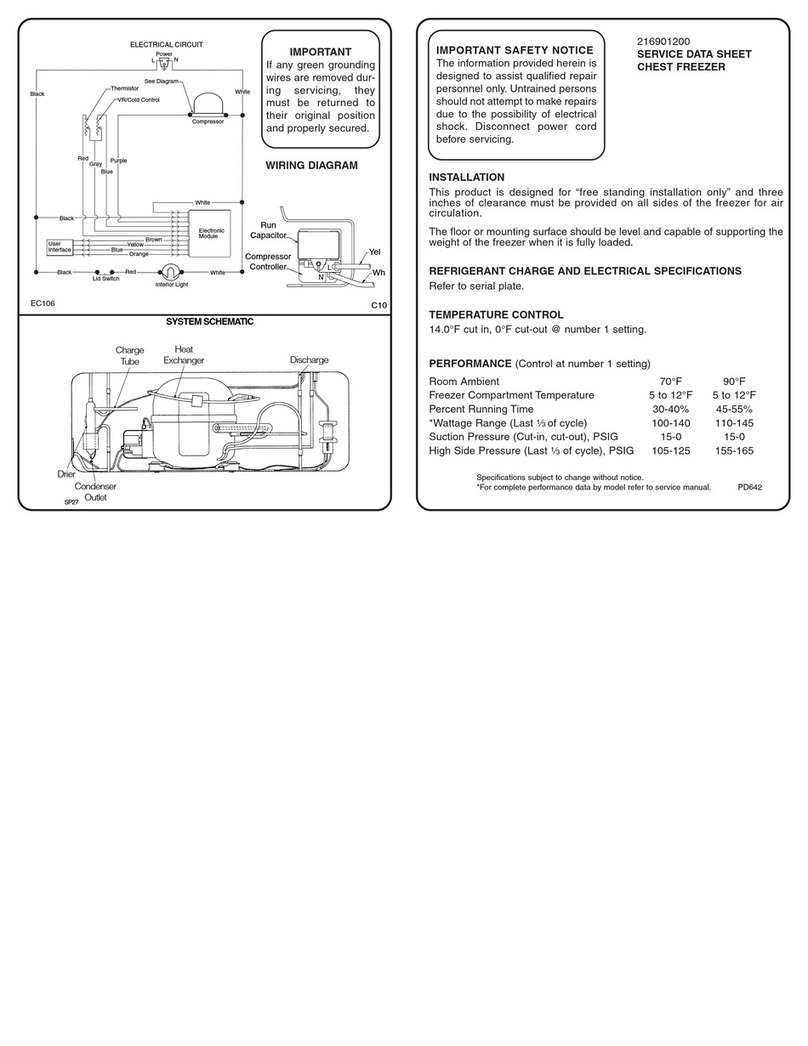
Frigidaire
Frigidaire GLFC2528FW - 24.9 cu. Ft. Manual Defrost Chest... Service data sheet
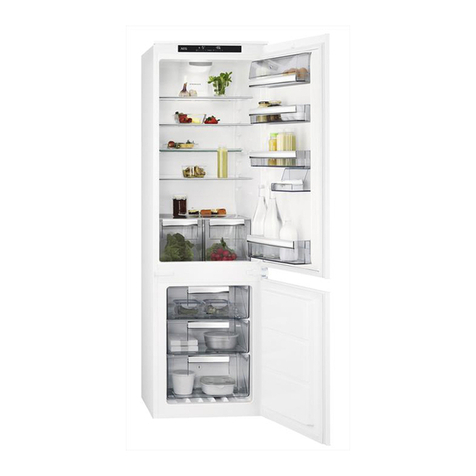
AEG
AEG SCB818E6TS user manual

Waeco
Waeco CoolMatic CB-36 operating manual

Maytag
Maytag GFU2046GRW owner's manual

Silver King
Silver King SKFMW50-ESUS1 Technical manual and replacement parts list
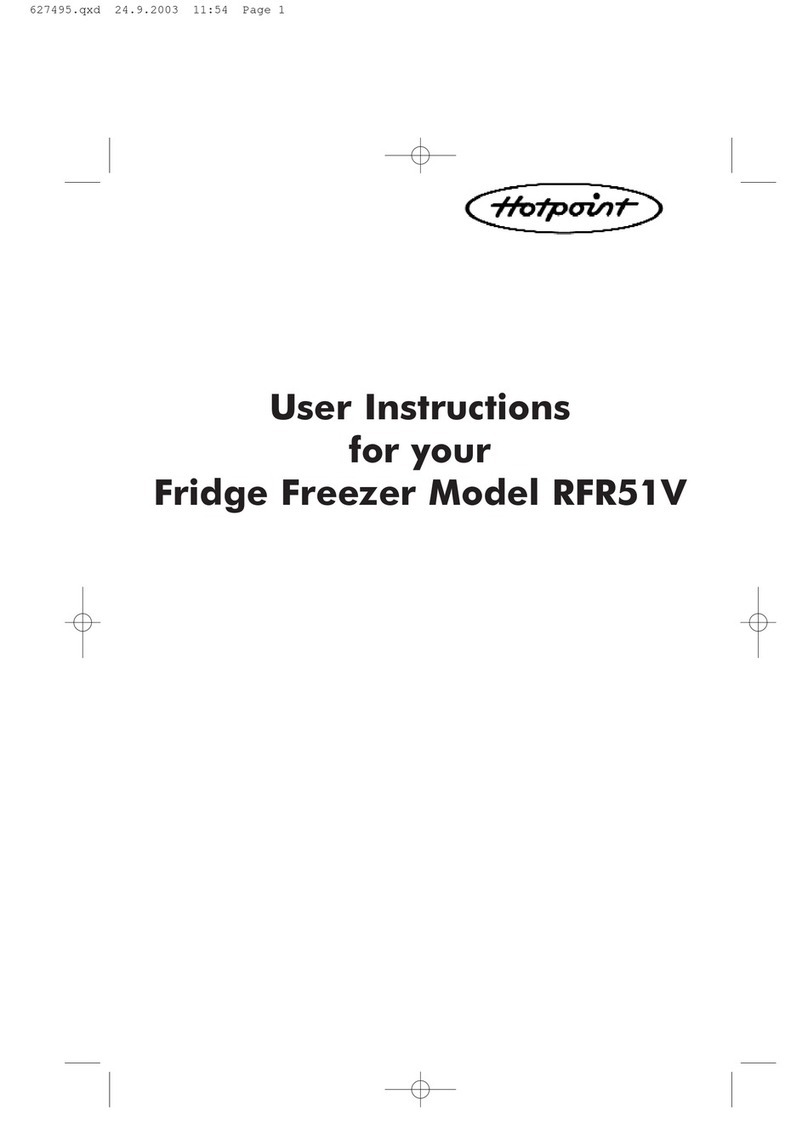
Hotpoint
Hotpoint RFR51V User instructions
